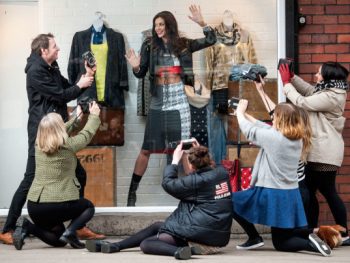Contributing writer for Wake Up World
Fashion: the second dirtiest industry in the world.
There’s been quite the buzz around zero waste over the last few years — and for good reason. As consumerism continues to mount worldwide, so is our trash and pollution problem. Oceans and waterways are clogged with ever increasing garbage, while massive landfills are unable to keep up with the sheer amount of refuge thrown their way. In response, up cycling movements have been slowly, but steadily, gaining momentum throughout Europe, and now in the United States and Canada as well.
Typically, zero waste is associated with innovative grocery markets like this one or as a personal quest to reduce our trash footprint to, well, zero. But the definition is expanding as more clothing manufacturers join the call to rein-in their wasteful practices. Considering fast fashion is the second dirtiest industry in the world, next to big oil, reforming this toxic business is one of the best things we can do for the health of the planet — and our own.
The Fashion Industry is Booming — and Destroying the Environment
[pro_ad_display_adzone id=”110028″]
It’s difficult to get our heads around the sheer number of people living on the planet today — with 7 billion and counting, the idea is almost unfathomable. Writer Melissa Breyer of TreeHugger gives the following analogy of just how many people inhabit planet earth and how it’s affecting the eco-system, especially when we look at the clothing we own.
“If you count one number a second without stopping until you reach a billion, you’d be counting for 31 years, 259 days, 1 hours, 46 minutes, and 40 seconds. That’s how much a billion is.
“If each person owned only one pair of pants, one shirt, and one jacket, that would be 21 billion articles of clothing. If you were to count each of those, one per second, it would take nearly 672 years. That’s a lot of clothes! And it’s safe to assume that many of us own more than three items of apparel.”
Add to this the trend of cheap and poorly-made clothing, along with the massive pollution the garment industry generates, and the picture becomes increasingly bleak. Breyer offers several additional statistics:
- The world clothing and textile industry (clothing, textiles, footwear and luxury goods) reached almost $2,560 trillion in 2010.
- In 2010, China’s textile industry processed 41.3 million tons of fiber and accounted for 52-54 percent of the world’s total production.
- The Chinese textile industry creates about 3 billion tons of soot each year.
- Millions of tons of unused fabric at Chinese mills go to waste each year when dyed the wrong color.
- A single mill in China can use 200 tons of water for each ton of fabric it dyes; many rivers run with the colors of the season as the untreated toxic dyes wash off from mills.
- In 2010, the textile industry ranked third for overall in Chinese industry for wastewater discharge amount at 2.5 billion tons of wastewater per year.
- The textile industry discharges about 300,600 tons of chemical oxygen demand (COD) waste and contributes to 8.2 percent of COD pollution in China.
Moreover, The Council for Textile Recycling estimates the average US citizen throws away 70 pounds of clothing and textiles annually, waste that ends up clogging our landfills.
Needless to say, fashion is a dirty business — but it doesn’t have to be. Creative designers are progressively embracing non-toxic methods of manufacturing and up cycling materials into new clothing — like what we are seeing with the zero-waste movement.
Fearless Designers and Smart Zero Waste Fashion
To gain a better understanding of how zero waste is applied to the fashion industry, we can look at avant-garde cuisine as an example. Instead of reinventing the wheel, chefs are essentially fusing together ideas which create something unique and innovative. The same can be said for zero waste clothing.
Says Mark Liu in What is Zero-Waste Fashion (and Why Does It Matter)?:
“Zero-waste design isn’t a new technology or material. Instead, it’s a new way of thinking — a philosophy that forces you to challenge existing techniques and become a smarter designer. Technique-wise, it involves fitting all the flat pieces of your clothing pattern like a jigsaw puzzle so no fabric is wasted. Considering that roughly 15 percent of the fabric is discarded when a typical garment is made, the cumulative effect of leaving behind no waste has far-reaching environmental consequences. More than that, however, zero waste about working within those constraints to invent beautiful new forms of fashion.”
[pro_ad_display_adzone id=”110030″]
Liu adds:
“Zero waste is avant-garde cuisine’s equivalent in fashion because it challenges the fundamentals of making clothing. Behind the seemingly effortless designs is a growing body of research that draws on different branches or science and mathematics. It requires pattern-making know-how, a working understanding of sustainability principles, and an inquisitive mind that is constantly learning.”
Have no doubt, zero-waste fashion is an art form. It takes skill and daring to create a beautiful article of clothing from scraps of fabric, and requires “smarter, more fearless designers who can see beyond drape and cut. Anyone can drape a rectangle of fabric, make a kimono, or stick some leftovers on a dress. But to make a zero-waste tailored ensemble for high fashion requires an entirely different level of skill,” said Liu.
While zero waste is making headway in the avant-garde fashion realm, companies that cater to the average consumer are also making positive strides in protecting the environment through their policies.
One well-known company is Patagonia, which has integrated a pioneering program that makes it easy to repair, buy, sell or trade Patagonia gear. Or, when the article of clothing or gear is worn out, you can return it to the company, so the item can be recycled into new fiber and fabric (or repurposed). The North Face Close the Loop program offers the same, as does Terracycle.
 Another company that is helping to reduce garment waste is Thred Up — and online consignment store which offers gently used, name-brand clothing at discounted prices. But for absolute zero waste fashion, Tonlé is the world’s first garment manufacturer that uses every bit of fabric, much of which is deemed unusable by large manufacturers. Tonlé even utilizes the smallest scraps, which are mixed with recycled office paper and sticky rice to produce their hang tags. Learn more about the vision behind Tonlé here.
Another company that is helping to reduce garment waste is Thred Up — and online consignment store which offers gently used, name-brand clothing at discounted prices. But for absolute zero waste fashion, Tonlé is the world’s first garment manufacturer that uses every bit of fabric, much of which is deemed unusable by large manufacturers. Tonlé even utilizes the smallest scraps, which are mixed with recycled office paper and sticky rice to produce their hang tags. Learn more about the vision behind Tonlé here.
Beyond supporting garment companies who have strong eco-friendly policies with minimal waste, we can also choose to invest in solidly-made clothing that will last for years, not months. It may cost more upfront, but the environmental benefit will span a lifetime.
Article sources:
- www.tonle.com/pages/zero-waste
- www.ecouterre.com/what-is-zero-waste-fashion-and-why-does-it-matter
- www.ecowatch.com/fast-fashion-is-the-second-dirtiest-industry-in-the-world-next-to-big…html
- www.weardonaterecycle.org
- www.treehugger.com/sustainable-fashion/25-shocking-fashion-industry-statistics.html
- www.terracycle.com/en-US/zero_waste_boxes/fabrics-and-clothing
- www.zerowasteeurope.eu/zw-companies-2/clothing
Recommended articles by Carolanne Wright:
- Psychiatric Industry Corruption: 6-Year-Old Boy Committed to a Psych Ward for Throwing a Temper Tantrum at School
- Renowned Harvard Psychologist Says ADHD is Largely a Fraud
- Plastic-Eating Mushroom Discovered in the Amazon Rainforest — A Solution for Our Trash Saturated World?
- Over 100 Scientific Studies Agree: Cannabis Annihilates Cancer
- Why Every Parent Should Consider Unschooling
- First U.S. City Produces More Electricity Than It Uses — With 100% Renewable Technology
- If You Care About Animals and the Earth, Here’s Why You Need to Boycott Palm Oil Immediately
- Brain Waves and Binaural Beats: A Gateway to Higher Consciousness, Enhanced Learning and Brain Function
- 85% of Tampons, Pads and Other Feminine Care Products Contaminated with Monsanto’s Cancer-Causing Glyphosate
- Latest Research on CBD Oil Offers New Hope for Healing Leaky Gut Syndrome and Autoimmune Disorders
- Scientific Breakthrough: Alzheimer’s Ultrasound Therapy Fully Restores Memory Function in Mice
[pro_ad_display_adzone id=”110025″]
[pro_ad_display_adzone id=”110027″]








